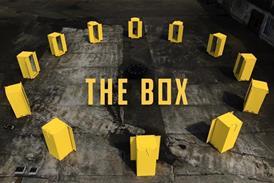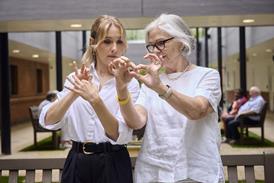U K studios take note: the rising cost of shooting drama and drama-documentaries in the UK, particularly if an expensive set is required, is causing an exodus of productions to overseas locations. When it comes to set construction, producers maintain that a third of budgets can be saved by relocating abroad. In eastern Europe, skilled crew can often be hired more cheaply than in the UK. While the logistical demands of filming overseas may be greater than for domestic shoots, the experiences of the five producers we talked to for this piece have been positive and all predict the trend towards filming abroad will continue.
Box TV, Romania
BBC1's The Last Enemy(90 minutes, 4 x 60-minutes) is due to air in the new year. Like previous Box TV dramas Boudica, Sweeney Toddand The Wind in the Willows, this large-scale drama has been shot in Romania.
'The logic of filming costume and historical drama in eastern Europe is sound,' argues executive producer Gub Neal. 'Funding is simply not available to produce in the UK to the quality expected by a broadcaster, whereas crew and construction are still relatively cheap in eastern Europe. If we filmed these productions in the UK we'd probably make them at a loss.'
Exteriors for The Last Enemy, set in contemporary Britain, were filmed in London with all interiors filmed at Bucharest's Castel Studios with a Romanian crew.
'I'm a tremendous advocate of the set-up in Romania at Castel or Media Pro Studios,' Neal says. 'The younger generation is totally familiar with film-making practices. They're brilliant to work with.'
Aside from the economic advantages, there are benefits to returning to the same place. 'You know what it means to hire extras, for example, and what the studios are capable of,' he says. 'The pitfall is that you can't precisely predict the volume of work that's going to be going through these places. They can get incredibly busy with Hollywood blockbusters and will sometimes take on more than they can handle. So you have to gauge whether they will deliver what they say they will.'
But that's not the same as being 'ripped off,' he stresses. 'Anyone with a horror story about eastern Europe hasn't done their job correctly.'
Neal believes TV construction will increasingly be outsourced overseas. 'As long as broadcasters want value they will have to bite that bullet,' he says. 'We're a long way from shooting HolbyCityin Bulgaria, but I don't think the prospect of filming a precinct drama series with a budget of less than £500,000 an hour overseas is far away.'
Pioneer Productions, Poland
Shooting in eastern Europe can shave a third off the budget, 'especially if your story is heavy with stunts, pyrotechnics and construction', says Pioneer producer Victoria Matthews.
Warsaw Film Studios and a nearby disused airstrip proved more cost-effective alternatives to big studio complexes in the UK when it came to building a replica of the famous airship for Hindenburg. An 8m x 4m metal skeleton of its wreckage plus interiors for the gondola were constructed. Back plates for CGI were also shot and sent to London's Rainbow Post for compositing.
'You can tap into skilled crew that you could never afford for this type of show in England,' she says, citing Hindenburg's production designer Ewa Skoczkowska, one-time art director on Schindler's List(and for Darlow Smithson Productions' drama-docs Sommeand Blitz).
Matthews liaised with local agency MS Films to line produce the project. 'I would persuade your DoP to use the local first AD,' she says. 'Most cinemato-graphers went to the renowned Polish National Film School in Lodz and have worked on huge projects. Don't be afraid of using local talent.'
There can however be communication issues. 'The DoP and sound engineer on Hindenburghad problems understanding each other. Things can take a bit longer as a result. In pre-production the director and I knew we could fly out easily and cheaply to supervise matters but you have to be prepared to hand over responsibility for certain aspects of the production [to the crew on the ground].'
Other internationally shot Pioneer productions include Challenger: Countdown to Disaster,for which Toronto provided a cheaper backdrop than Houston, and Krakatoa, for which the production returned to Indonesia, scene of the 1883 eruption.
Raw Television , Mexico
Banged-Up Abroadrecreates the nightmarish true stories of holidays gone wrong and revisits the original locations as far as possible to achieve maximum authenticity.
For series two of the 4 x 48-minute drama-docs for Five and National Geographic, Raw visited Peru, Nepal, Hong Kong, LA and Brazil (doubling for Colombia because of security risks).
The first in the series, directed by creative director Bart Layton, concerns two Leicestershire teenagers caught leaving Venezuela with 20 kilos of cocaine and sentenced to 10 years behind bars.
'We couldn't film in Venezuelan jails because of the risk of kidnapping,' says Layton, who substituted Mexico partly because he had contacts there.
'I work with Mexican fixers who know how to get us access to difficult locations like prisons and airports,' adds Layton, a fluent Spanish speaker.
'There's a very particular way of doing business there. Without wanting to generalise, you have to deal with them as they would deal with you. There's a certain amount of palm-greasing. But it mustn't be overt.'
To obtain permission to film inside a maximum security regional penitentiary, Layton supplied the prison with basketballs, sanitary equipment and a rudimentary tannoy system. The governor got his own cheap PC.
'We want to be as unobtrusive and documentary-like as possible because of the subject matter so we use minimal crew and a handful of actors mixed with non-professional extras like guards and inmates,' he explains. 'I made it very clear to the actors what they were signing up for. They were expected to muck in and help rig lights and set up tracks.'
There were also moments where matters could have got out of hand. 'We staged a riot with 140 prisoners which very nearly tipped over the edge into the real thing. The actors were shaken up. I definitely felt increased responsibility over them but I think it's this energy which makes it feel real.'
Shooting in extreme locations involves risks that producers wouldn't come across in the UK. Raw executive producer Dimitri Doganis has encountered poisonous snakes on set in Brazil, had rushes seized by Thai ministry of information officials 'suddenly uneasy about what we're shooting' and had equipment break down because of jungle humidity.
On the plus side there are considerable untapped sources of local funding available to producers wanting to shoot abroad.
'The way in which factual production tends to be funded in Britain has given us a relatively narrow view of how we raise finance,' says Doganis. 'Unlike film producers, TV producers have little experience of maximising all the available incentives.'
Tiger Aspect , Hungary
The second 13 x 45-minute £10m series of BBC1's Robin Hoodreturned to Hungary for 26 weeks earlier this year after the very public theft of master tapes from Tiger Aspect's Budapest production office during series one.
'It was shocking and alarming but something that could happen anywhere,' says executive producer Greg Brenman. 'The locals were as surprised and shocked as anyone. We did think twice about going back there but the fact is they offered us an impressive service first time round.'
Returning to Fot Studios, outside Budapest, also saved having to rebuild the extensive sets, including the main castle, which predated the production and was a primary reason for Fot's selection.
'We wanted a place with a vast open forest without overhead aircraft or electric pylons,' Brenman explains. 'The pre-existing 'castle' saved us a massive construction. The landscape is not instantly recognisable and we'd have guaranteed good weather for the shoot's duration.'
The production employed a Hungarian first AD, art director, stunt co-ordinator and VFX team, which set up as an independent company following the first series. Post-production was switched from Hungary to the UK after the theft debacle, with rushes sent daily via FTP.
'For the first series, post wasn't as efficient as it needed to be on site,' says head of drama production Frith Tiplady. 'We're filming HD with 5.1 sound, which is more complex than film. Also, we need editors who are able to understand the BBC's delivery requirements.'
Brenman's criteria for locations are based on cost, whether there's a good fit between location and the programme's content. He also sees locating productions abroad as a means of varying the audience's experience. 'We've based the last two series of Murphy's Lawin Dublin, although the series is largely set in London, because the capital is prohibitively expensive. Ireland has rural, coastal and urban locations within 25 minutes of each other,' he says. 'But we shot The Secret Diary of a Call Girlin London because the nature of the piece meant it couldn't be shot elsewhere.'
Red Production, Tunisia
The Tunisian desert and towns rather than controllable sets proved an ideal backdrop for Red to stage a three-week exterior shoot for Iraq war drama The Mark of Cain.
'Filming on location increases the project's authenticity on screen and helps the whole crew understand what you are trying to achieve,' argues producer Lynn Horsford.
'The first challenge was finding a substitute location for Iraq and we looked at them all - Morocco, Dubai, Turkey, even Canada, where we heard an entire Baghdad set had been built. But we chose Tunisia because there was an infrastructure we felt we could tap into.'
Previous productions - notably the 2004 feature The Tiger and the Snow- had familiarised local fixers and crew with productions of this scale. And French was their second language, 'so our English heads of department had a chance of understanding them', Horsford recalls.
Aside from working temperates of more than 40 degrees (in a culture which sensibly rests over midday) and managing the sensitivities of the area's Iraqi population, the biggest hurdle was negotiating to film at the international airport.
'We'd got the permit and recced the site three times but we were inexplicably denied at the eleventh hour. We had the whole unit standing round which is very expensive. We ended up recreating the scene at a freezing cold Manchester airport and fixing it in post.'
tips for shooting abroad
Select local agencies based on the recommendations of producers who have shot in the region
Ensure you have back-up equipment. Not all territories have HD kit available and you may need to fly it out
Use local crew. Local technicians are often extremely experienced but camera ops are not necessarily cheaper than the UK
Build relationships. A rapport with the local crew makes life easier
If you feel strongly enough about key heads of department, take them
In more extreme locales you can't pick up the shots you missed. It pays to plan rigorously and ensure the director and broadcaster are clear about what to expect
Allow extra time in preparation and filming. Expect the unexpected






























No comments yet